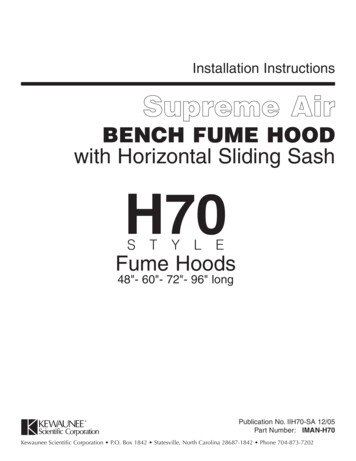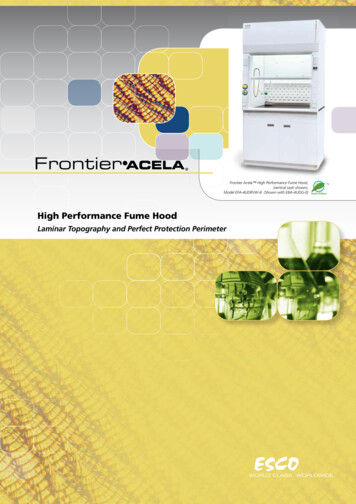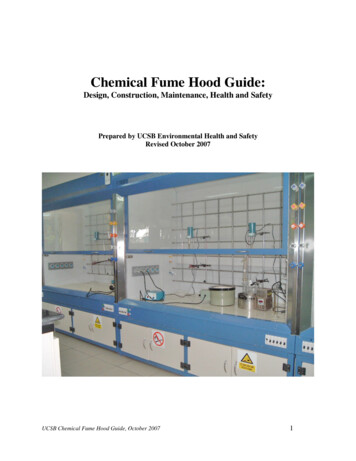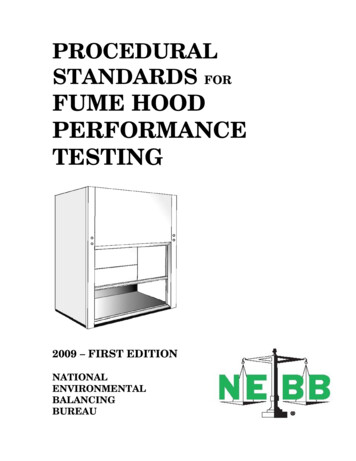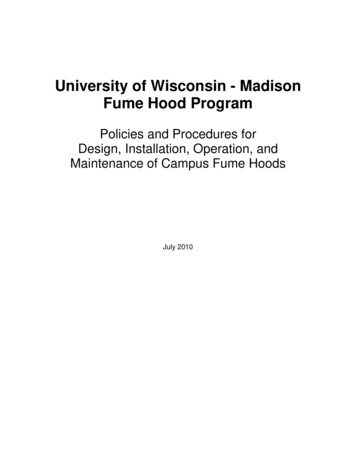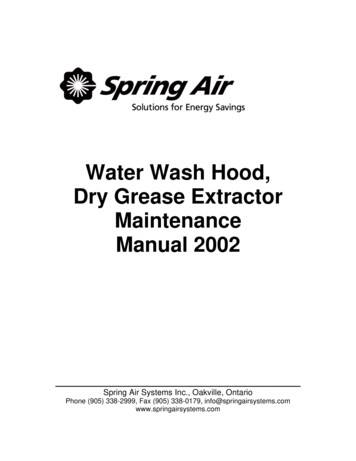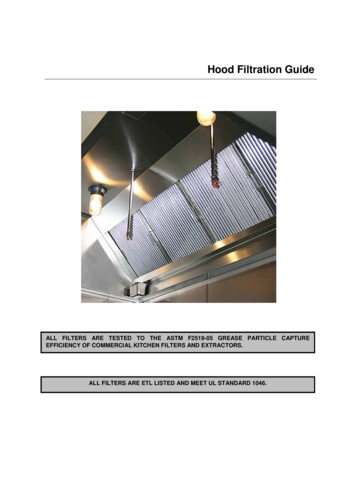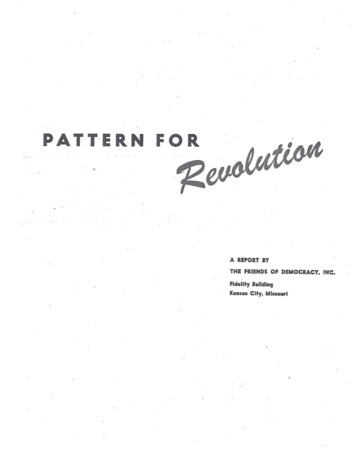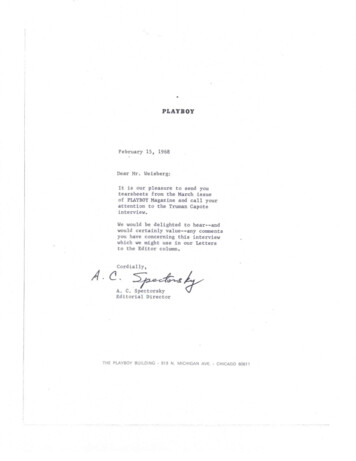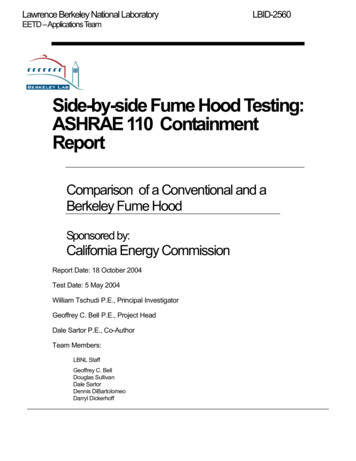
Transcription
Lawrence Berkeley National LaboratoryLBID-2560EETD – Applications TeamSide-by-side Fume Hood Testing:ASHRAE 110 ContainmentReportComparison of a Conventional and aBerkeley Fume HoodSponsored by:California Energy CommissionReport Date: 18 October 2004Test Date: 5 May 2004William Tschudi P.E., Principal InvestigatorGeoffrey C. Bell P.E., Project HeadDale Sartor P.E., Co-AuthorTeam Members:LBNL StaffGeoffrey C. BellDouglas SullivanDale SartorDennis DiBartolomeoDarryl Dickerhoff
LAWRENCE BERKELEY NATIONAL LABORATORYEETD – APPLICATIONS TEAMTable of Contents1Executive Summary .12Overview .134562.1Testing Fume Hood Containment Performance.12.2Side-by-side hood evaluations .22.3Summary of Results.3Test Procedure.53.1Test Description.53.2Instrumentation.63.3Acceptability Level.73.4Deviations from ASHRAE 110 Test Procedure.7Side-by-side Setup .74.1Conventional hood configuration.74.2Berkeley hood configuration .84.3Mannequin Setup .8Test Run Narrative.135.1Flow Visualization test runs .135.2Face Velocity measurements .135.3Static Tracer Gas test runs .135.4Sash Movement Effect runs .145.5Sash Periphery Traverse test runs.14Appendix A - Side-by-side Containment Test Runs.15ILBID-2560
LAWRENCE BERKELEY NATIONAL LABORATORYEETD – APPLICATIONS TEAMLBID-2560Side-by-Side ASHRAE 110-1995 Fume Hood TestingConducted at Lawrence Berkeley National Laboratory, Bldg. 63-1031Executive SummaryLawrence Berkeley National Laboratory (LBNL) has developed and patented a highperformance fume hood, The Berkeley hood. The Berkeley hood’s main design featureuses a gentle flow of air, introduced at the sash perimeter, to direct fumes inside the hoodaway from the face of the hood, and therefore away from the user. This push-pullapproach not only provides for improved containment and greater operator safety, but alsoallows for much lower exhaust volume – 50% lower in the tests reported herein –dramatically reducing the amount of conditioned air that must be continually supplied andexhausted to a laboratory.The side-by-side fume hood testing compares two otherwise identical hoods – oneconventional and one Berkeley hood – by measuring the escape of a tracer gas from eachper the American Society of Heating Refrigeration and Air-conditioning Engineers(ASHRAE) 110-1995 Method (more below). Test results indicate that the Berkeley hoodprovides substantially better containment of potentially harmful fumes, and thereforegreater operator safety, than a conventional fume hood. It outperformed the conventionalhood in all tests.22.1OverviewTesting Fume Hood Containment PerformanceThe purpose of an enclosing or containment laboratory hood is to contain toxic materialsgenerated within the hood in order to keep exposure to laboratory hood users below therelevant health hazard exposure guidelines (e.g. OSHA PEL’s or ACGIH TLV’s). It haslong been recognized that many factors affect the hood’s ability to contain including facevelocity, hood design, room airflow patterns and user activities. Prior to the 1980’s, facevelocity and visual smoke observations were used as the major indicators of hoodperformance. Recent studies have indicated that face velocity alone may not be predictiveof adequate hood performance.12.1.1ASHRAE 110-1995 MethodThe American National Standards Institute and ASHRAE Standard, ANSI/ASHRAE 1101995, Method of Testing Performance of Laboratory Fume Hoods, is the foremost protocolused when testing laboratory-type fume hood performance. The ASHRAE-110 “Method”is an elaborate, three-part test that involves face velocity testing, flow visualization, and atracer gas test. However, the ASHRAE 110 standard specifies the test, not theperformance standard.1From correspondence by ANSI/AIHA Z9.5 Standards committee, June 2003.1
LAWRENCE BERKELEY NATIONAL LABORATORYEETD – APPLICATIONS TEAM2.1.2LBID-2560ANSI/AIHA Performance StandardUsing the ASHRAE 110 tracer gas containment test, the American National StandardsInstitute (ANSI) and American Industrial Hygiene Association (AIHA) have establishedcontainment performance standards in ANSI/AIHA Z9.5-2003 for as manufactured (AM)as installed (AI), and as used (AU) fume hoods established by ASHRAE. In this case,“performance” refers to the level of confinement of possible hazards and protection of theemployees for the work which is performed inside a laboratory-type hood.An interpretation was solicited from the ANSI/AIHE Z9.5 committee to provide aninterpretation of a section in the ANSI/AIHA Standard for Laboratory Ventilation,ANSI/AIHA Z9.5-2003, regarding an equivalent performance indicator for “traditional” facevelocity. This interpretation would be used to evaluate laboratory-type hoods havingdesign features that do not use traditional face velocity as their method of confinement.2.1.3ANSI/AIHA Performance ThresholdsThe response from ANSI/AIHA to the solicitation, noted above, to an equivalentperformance indicator for “traditional” face velocity with performance thresholds wasprovided:“Therefore ANSI Z9.5 requires that some form of containment test using a challengeagent such as a tracer gas that can quantitatively measure hood “leakage” be used todetermine if a hood’s containment is acceptable. The hood “user” or “owner” needs todefine what containment is acceptable. At the current time ANSI Z9.5 recommendsthat ASHRAE 110-1995 be used as this containment test. For a 4 lpm challenge therecommended maximum acceptable “leakage” is 0.05 ppm at the breathing zone forhoods tested under controlled conditions and/or 0.1 ppm for hoods as installed in thelaboratory.”22.22.2.1Side-by-side hood evaluationsComparative ApproachIn an effort to demonstrate equivalent or superior performance of a Berkeley fume hoodcompared to a conventional fume hood (see next section), the California EnergyCommission (CEC) sponsored a series of so-called “side-by-side” comparativeperformance evaluations. An example of each hood type was installed and tested in thesame room. The basic hoods were produced by the same manufacturer (JamestownMetal Products) and are of the same nominal size. Testing method employed was theASHRAE 110-1995 protocol. Containment performance threshold levels were obtainedfrom the ANSI Z9.5-2003 Laboratory Ventilation Standard. This report provides theresults for the side-by-side tests. A companion report provides results for an innovativehuman-as-mannequin (HAM) side-by-side test series.2.2.2An Innovative Laboratory-type hoodResearchers at Lawrence Berkeley National Laboratory (LBNL) are developing aninnovative containment technology that reduces required airflow through laboratory fumehoods. This technology provides containment at 50 to 70 percent lower airflow than a2From correspondence by ANSI/AIHA Z9.5 Standards committee, June 2003.2
LAWRENCE BERKELEY NATIONAL LABORATORYEETD – APPLICATIONS TEAMLBID-2560typical fume hood, based on total exhaust volume. It does not rely on face velocity, in thetraditional sense, to maintain fume containment within a hood.The LBNL containment technology uses a "push-pull" displacement airflow approach tocontain fumes and move air through a hood. Displacement air “push” is introduced withsupply vents near the hood’s sash opening. Displacement air “pull” is provided bysimultaneously exhausting air from the hood. Thus, an “air divider” is created, between anoperator and a hood’s contents, that separates and distributes airflow at the sash opening.This air divider technology is simple and increases operator protection.2.32.3.1Summary of ResultsSuccessful Containment PerformanceTable 1 presents the complete results from the ASHRAE 110-1995 Method, includingtracer gas containment performance per ANSI/AIHA thresholds. Note that both theconventional and Berkeley hood “pass”, per ANSI Z9.5-2003.Table 1: ASHRAE 110 Test results for Side-by-side Conventional and Berkeley hoodsRunTest tContainmentContainmentContainmentAIAMAIAM(as installed)(as mf’g)(as installed)(as mf’g)Hood1Local FlowVisualizationSmall volumeSmoke FlowVisualizationLarge volumeSmokeVisualobservation;no mannequinGoodGoodGoodGood3Face VelocityVelocity meterPass4StaticMannequinTracer gasEjector Centerposition; Sashfull openPassaPassaPassaPassa5StaticMannequinTracer gasEjector Leftposition; Sashfull openPassaPassaPassaPassa6StaticMannequinTracer gasEjector Rightposition Sashfull openPassaPassaPassaPassa7Sash MovementEffect (SME)Tracer gasEjector Centerposition SashoperatedPassbPassbPassbPassb8Sash MovementEffect (SME)Tracer gasEjector Leftposition SashoperatedPassbPassbPassbPassb9Sash MovementEffect (SME)Tracer gasEjector Rightposition eTracer gasEjector Centerposition; Sashfull open; nomannequinPassbPassbPassbPassbN/APassN/AN/Aa. Tracer gas Pass/Fail criterion per ANSI Z9.5 2003.b. No specified Tracer gas Pass/Fail criterion per ANSI Z9.5 2003; however, compared to static mannequinguidelines and an averaged value during the test, a pass rating was achieved.3
LAWRENCE BERKELEY NATIONAL LABORATORYEETD – APPLICATIONS TEAM2.3.2LBID-2560Superior Containment PerformanceExamining quantitative data, in Table 2, shows that the Berkeley hood provides superiorcontainment performance, per ANSI Z9.5-2003, to the conventional hood.Table 2: ASHRAE 110 Test results for Side-by-side Conventional and Berkeley hoodsTracer Gas TestPosition/TypeConventional(Aver PPM for 5 Min.)Berkeley(Aver PPM for 5 1SME Center0.0250.001SME Left0.0210.002SME Right0.0120.001bPeriphery Traverse0.0220.001a.) Includes unscheduled AI door opening and closing during test run.b.) Corrected for increasing level of background SF6 tracer gas (0.006 withoutcorrection).2.3.3Containment Performance ComparisonChart 1 presents comparative results for the ASHRAE 110 tracer gas containment testsaveraged over a 5-minute interval. Note that both the conventional hood and the Berkeleyhood performed very well by providing containment far below the ANSI Z9.5 2003threshold for an as-installed (AI) hood of 0.10 PPM. Importantly, the ANSI containmentthreshold for the more stringent as-manufactured limit of 0.05 PPM was also achieved byboth hoods.4
LAWRENCE BERKELEY NATIONAL LABORATORYEETD – APPLICATIONS TEAMLBID-2560Chart 1: Comparative containment for Side-by-side Conventional and Berkeley hoods33.1Test ProcedureTest DescriptionAll tests followed ASHRAE’s 110-1995 test methods for flow visualization and tracer gastests, Section 6.1 and Section 7, respectively. Face velocity tests were performed oneach hood; however, the Berkeley hood face velocity tests were performed without thehood’s supply fans in operation. Refer to ANSI/ASHRAE 110-1995 for specific informationregarding its Purpose (Section 1), Scope (Section 2), Definitions (Section 3),Instrumentation and Equipment (Section 4), and Test Conditions (Section 5). The tests,referenced below, used the ASHRAE 110 method’s Section 6.1, Flow Visualization andSection 7 (7.1 through 7.10), Tracer Gas Testing Procedure to evaluate containmentperformance. A general overview of these tests is provided:1) Flow visualization tests can be performed with various smoke-generating substances.Theatrical smoke, superheated glycol, smoke “sticks”, titanium tetrachloride, and dryice, solid-phase CO2, are examples of smoke sources. A qualitative understanding ofcontainment is gained from conducting smoke tests. A rating system has beendevised for “poor- to-good” patterns of smoke containment by Tom Smith3. However,3Tom Smith, President of Exposure Control Technologies, Inc. 231-C East Johnson St. Cary, NC 27513ph: 919.319.42905
LAWRENCE BERKELEY NATIONAL LABORATORYEETD – APPLICATIONS TEAMLBID-2560these tests are only used as indicators of containment. When satisfactory results areobserved, they should be followed by tracer gas testing. Both small and large volumesmoke tests were performed on each hood with full containment of all smoke clearlymoving towards the rear of the hood without any “reverse return” flow noted.2) Face velocity measurements are performed by using a “hot wire” velocity meter withits probe held fast in a stand. This removes any variability that a person mayintroduce into the data. An imaginary grid of one-foot squares provide the location forthe meter’s probe, which is centrally located in each square foot area. For the sideby-side tests, each hood’s grid had three rows and five columns, yielding fifteenreadings that were averaged. Each hood’s averaged reading compared we
Side-by-Side ASHRAE 110-1995 Fume Hood Testing Conducted at Lawrence Berkeley National Laboratory, Bldg. 63-103 1 Executive Summary Lawrence Berkeley National Laboratory (LBNL) has developed and patented a high-performance fume hood, The Berkeley hood. The Berkeley hood’s main design feature uses a gentle flow of air, introduced at the sash perimeter, to direct fumes inside the
